Books
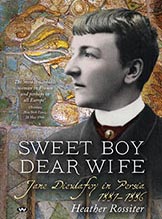
Sweet Boy Dear Wife Jane Dieulafoy in Persia 1881–1886
Captivated by enamelled tiles and bricks used in Islamic buildings, Jane Dieulafoy’s search in great cities and small villages, despite illness, religious fanatics and wild tribesmen, is an exciting story of risk and resolve. Blue-eyed Jane dressed as a boy to accompany her husband on digs in Persia, where women were veiled and enclosed. Her adventures led to the unexpected discovery of enamelled brick friezes in the 2500-year-old city of Susa. Displayed at the Louvre Museum, Paris, in 1886, the Lion and Archer friezes created a sensation and remain today among the Louvre's greatest treasures.
» Read more
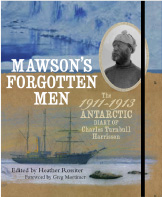
Mawson's Forgotten Men The 1911-1913 Antarctic Diary of Charles Turnbull Harrisson Edited by Heather Rossiter
Mawson's Forgotten Men The 1911-1913 Antarctic Diary of Charles Turnbull Harrisson is more than a record of cold and courage; it is a 520-page love letter to his wife Carrie.
Charles Turnbull Harrisson (1867-1914) was the only Tasmanian member of Douglas Mawson's legendary Australasian Antarctic Expedition 1911-14. Appointed biologist and artist to the expedition, Harrisson was a gifted writer. His diary of December 1911 to March 1913 records the challenges that faced the 8-man Western Base party landed on a glacier 2000km west of the Main Base, and their heroic achievements in Queen Mary Land. Transcribed and edited by Heather Rossiter, Harrisson's engaging narrative is complemented by his oil and watercolour paintings, pencil sketches made in the field and many photographs.
In bringing Harrisson's diary from obscure library storage to published volume, Rossiter honours the daring spirit of these lesser known but equally audacious Antarctic explorers.
» Read more
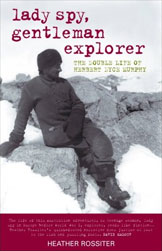
Lady Spy, Gentleman Explorer The double life of Herbert Dyce Murphy
Herbert Dyce Murphy inspired Patrick White's The Twyborn Affair; he appears as a woman in one of E. Phillips Fox's best-known paintings; he prevented Douglas Mawson's Antarctic expedition from imploding.
Lady Spy, Gentleman Explorer tells the story of one man's fascinating double life–a gentleman adventurer who also dressed in drag to spy for British Military Intelligence in pre-World War I Europe.
In 1911 Murphy sailed to the Antarctic with the Mawson expedition for a gruelling exploration of the frozen continent, a trip of terrible hardship which claimed lives-probably unnecessarily-as this controversial view of Mawson demonstrates.
Brilliantly researched and beautifully written, Heather Rossiter's Lady Spy, Gentleman Explorer gives Murphy's unforgettable story its due at last.
Using diaries held by the Mitchell Library [Rossiter] weaves an account of bravery, hardship and determination in the face of almost unimaginable odds.
» Read more
Antarctic Writings
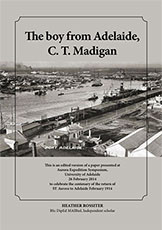
The Boy from Adelaide, C. T. Madigan
The Antarctic Diaries of C.T. Madigan, transcribed by J.W. Madigan and published in 2012 as Madigan's Account: the Mawson Expedition, present a new perspective on the AAE 1911-1914. While the narrative of major events is familiar, emphasis and interpretation in Madigan's diaries undermine much of the mythology created around the expedition.
This author has previously argued that during the Heroic Era diaries were the most authoritative form of reporting Antarctic experience. Madigan's dairies not only record his experience; unintentionally they also record his changing awareness as events modified the way he perceived and understood Antarctica and the expedition. Educators refer to changes in perception and understanding as 'learning'. Much of Madigan's 'learning' was painful.
A diary is not only an authoritative record of experience; it is also a log of a changing persona as what is experienced transforms the self. In his diaries, Madigan both consciously and unconsciously reveals changes in his character and personality. The experiences that effected this transformation were sometimes tragic, others more benign.
» Read more
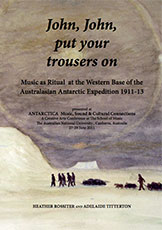
John, John, put your trousers on Music as Ritual at the Western Base of the Australasian Antarctic Expedition 1911-13
Although music was an integral part of the religious observance conducted almost every Sunday at the Western Base of the Australasian Antarctic Expedition, the AAE, it is not religious music, but music in the primary role of secular ritual that is the subject of this paper. Several definitions of ritual are considered and behavioural patterns at the base tested against them.
Using these parameters, three rituals are identified. One began their day, a second marked the end of the week, and another of less regular occurrence initiated assaults on the Antarctic's secrets. Using diary extracts and other sources, the origins of each ritual are traced, its expression and affective dimensions analysed, and the psychological benefits deduced. The contribution of the rituals to the social harmony that was so much a feature of the base is evaluated.
» Read more
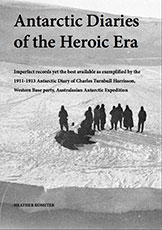
Antarctic Diaries of the Heroic Era Imperfect records yet the best available as exemplified by the 1911-1913 Antarctic Diary of Charles Turnbull Harrisson, Western Base party, Australasian Antarctic Expedition
The centenary of the departure of the Australasian Antarctic Expedition (AAE), celebrated in Hobart on 2 December 2011, ignited interest in the documenting of 'Heroic Era' expeditions and of the AAE 1911-1914 in particular. Simultaneously, the publication of artist and biologist Harrisson's diary as Mawson's Forgotten Men The 1911-1913 Antarctic Diary of Charles Turnbull Harrisson revived the almost vanished memory of the Western Base party of the AAE, an heroic group of eight whose endeavours bestowed reality on 2400 km of previously uncharted Antarctic coastline and legitimated the mythical Antarctic hinterland from 88° to 101° E Longitude.
» Read more
Mawson's forgotten men weathered it all, only to be frozen out of history
Exactly 100 years ago, on January 8 1912, a brilliant ice-master brought his refitted whaling ship safely into an Antarctic bay studded with snow-capped rocks.
Captain John King Davis was not hunting leviathans, he was searching for a place to land the second party of the Australasian Antarctic Expedition. The water was Commonwealth Bay. Beside Davis on the bridge stood the expedition's leader Douglas Mawson, rather green about the gills after weeks of seasickness.
» Read more
Mawson's Unremembered Men
On 2 December 2011 the centenary of the departure of the Australasian Antarctic Expedition will be celebrated. The Derwent will again be alive with Antarctic-bound shipping, a flotilla of yachts and the Egeria, direct descendant of the Egeria in which Sir Harry Barron, the then governor of Tasmania, had accompanied the SY Aurora as far as the Iron Pot where in 1911 forty Greenland huskies were taken on board.
» Read more
The Forgotten Tasmanian
Charles Turnbull Harrisson was the only Tasmanian member of the Australasian Antarctic Expedition, led by Dr Douglas Mawson. Their departure from Hobart on 2 December 1911 will be re-enacted in December this year.
Harrisson grew up at Kingston, south of Hobart. His father was an orchardist on Brown's River Road, not far from the present site of the Australian Antarctic Division.
» Read more
The Silence Roars in my Ears, Unsung Early Australian Antarctic Exploration History by Heather Rossiter
Revisionist history is overwhelming us. It has become almost impossible to pick up a magazine or journal and not find aspects of it: a review of a book written from a revisionist perspective, an article on the political implications of a revisionist work, a defence of a revisionist interpretation, a justification of actions that have been revisionistically interpreted. So history is tossed like a salad as it has always been. Does it matter? The next generation will read its history with its own prejudices, will interpret it in accord with a new agenda, while a few of its scholars will refer to primary sources and present what they see as objective truth.
» Available on Informit
Articles and travel pieces
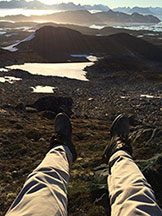
Into the Arctic with two Minders by Heather Rossiter
Dear Diary,
So here I am tucked up in Iceland with my minders, a volunteer rural firefighter to cover the volcanos and a surf lifesaver to deal with petulant hot springs. Can't wait to explore Reykjavik tomorrow. The landscape is truly weird.
Our hotel sat on a hill above Reykjavik's town centre. Most of R does; it's a very hilly town. Lifesaver was guide. Charmed by bright-coloured houses and tumbling rose gardens it was some time before I became uneasy. We were beside a lake, not a harbour, and the substantial city buildings seemed to be getting smaller. Not a word: Lifesaver is leader today.
» Read more
Bailed up in Benalla by Heather Rossiter
In Kelly country, on my way to the Victorian goldfields, I was bailed up in Benalla. Not by Ned, though he was there swaggering out of a tapestry by Sydney Nolan on a wall at the Benalla Art Gallery, but by the charm of this country town. I was held for a day when I should have been in Bendigo.
I arrived early one morning just as the local bakeries were setting out their chairs. Restored by coffee and croissant, I crossed a bridge and saw an elegant modern building jutting out towards the lake, the Benalla Art Gallery. Just pop in, I thought, but the collection trapped me.
Laurie Ledger, major donor, obeyed his mother who said, include women artists. Thanks to her Benalla has some memorable works, such as Alice Bale Interior 1906, an enchanting view across a room into a light-filled hallway where a figure waits ... to open a door? to eavesdrop a conversation? Rather killed by its heavy gilded frame, but that was contemporary fashion.
» Read more
Ataturk's Daughters ...And His Granddaughters, Too by Heather Rossiter
In Istanbul, Heather Rossiter went looking for women scientists
When the corrupt, moribund and defeated Ottoman Empire was overthrown in 1923, Mustafa Kemal Ataturk became the first President of the Republic of Turkey. Among his many reforms none was more significant than his recognition of the rights and abilities of Turkish women. Throw off your headscarves, come out of your seclusion, he told them, and participate on equal terms with men in building a new secular society and a new nation. Edicts decreed that a woman's head should be uncovered in classroom, university and government office. Scholarships were made available for women to undertake further study at European universities. Women became full citizens and much was expected of them. The change in their status and expectations was revolutionary. They did not disappoint; their achievements were incredible.
» Read more
Granny was here by Heather Rossiter
Cousin Graeme says Schooner Cove is the only possible place, and he should know. He was master of a cruise boat on Port Davey for four seasons.
That pleasure palace now laid up, how to get to a place that has no roads? By air is the answer: take the South West World Heritage tour.
Why do I want to go there? Well, when my Granny was little she lived at Forest in northwest Tasmania. The view was Bass Strait. East-west roads barely existed, the centre of the island was impassable. Produce and people came and went from the little ports strung along the coast. Enrolled at Collegiate School, Hobart, in the early 1890s, twice a year she boarded a coastal trader at Stanley and sailed down the wild west coast; twice a year she made the return.
» Read more
Book Reviews
MThe Unknowable Mawson by Heather Rossiter
A review of 'Mawson: A life' By Philip Ayres Miegunyah Press 1999. Quadrant November 1999 p. 81.
» Available on Informit
Mawson: A life by Philip Ayres
'The Unknowable Mawson' by Heather Rossiter, a review of 'Mawson: A life' published in Quadrant.
» Available on Informit
That First Antarctic Winter by Janet Crawford
'Squabbling while the Pole Freezes' by Heather Rossiter, a review of 'That First Antarctic Winter' published in Quadrant.
» Available on Informit
Stalin: The Court of the Red Tsar by Simon Sebag Montefiore
Strange to read a book in which there is not a single hero. Stalin: The Court of the Red Tsar opens with a dinner party in the Kremlin on November 8, 1932, prelude to the suicide of Joseph Stalin's young wife, Nadya. The author describes the dress she wore, the scarlet tea rose in her black hair and how she and Stalin quarrelled. The dialogue is verbatim. Such detail instantly draws the reader into the circle of violent criminals who ruled the Soviet Union from 1929 to 1953. By the time Nadya crosses the lane to the flat in the Poteshny Palace and picks up a lady's Mauser pistol, the reader is entrapped, just like Stalin's victims, like Nadya's sister, like her sister-in-law.
» Read more
The Sword and the Cross by Fergus Fleming
Here is a paradox: a serious, almost scholarly account of French imperialism in North Africa in the 19th and 20th centuries which is impossible to read without screaming with laughter. The Battle of Tit is straight from the theatre of the absurd, and from the reports of General Henri Laperrine, the "sword" of the title, comes this piece of French farce. While touring a garrison almost lost in the Saharan emptiness, Laperrine challenged a young officer to the effect that pillaged caravans disrupted trade and "everything I saw did not tally with the optimism of his reports, and I instructed him to react vigorously at the first sign of aggression".